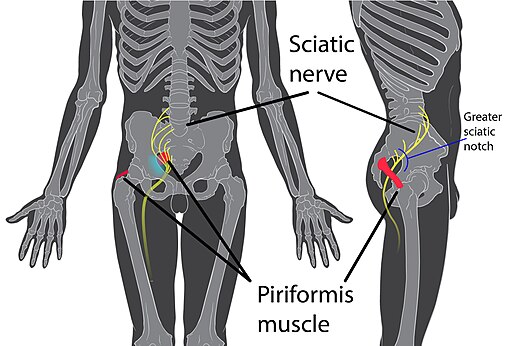Piriformis Syndrome: A Real Pain in the Butt
Piriformis syndrome can be a nagging pain in the butt… literally!
There is a lot of research being done to help us understand how exactly the piriformis muscle may be contributing to pain felt in the gluteal region or down the lower extremities.
In this blog we are going to break down the anatomical structures involved in Piriformis Syndrome, understand symptoms related to Piriformis Syndrome, our approach to treatment and why stretching the piriformis muscle alone may not be enough to resolve the issue.
What is the piriformis muscle and sciatic nerve?
The piriformis muscle is located in the gluteal region of your pelvis. It attaches from the anterior (front) side of your sacrum to the greater trochanter of your femur.
The primary function of the piriformis muscle is to laterally rotate (externally rotate) the thigh and it aids in abduction (lifting the leg out to the side) and flexion of the thigh (bringing your knee to your chest).
The sciatic nerve is the largest nerve in the human body. It originates from the lumbar and sacral portions of the spinal cord and runs along the posterior (back) side of the thigh and lower leg into the toes.
Compression of the sciatic nerve (or any nerve) can cause pain, numbness, tingling or even weakness along the path of the nerve either directly at the site of compression or further down the path.
What is Piriformis Syndrome?
Piriformis Syndrome occurs when contraction of the piriformis muscle compresses the sciatic nerve. Aggravation of the sciatic nerve can cause localized pain deep within the glutes, as well as numbness, tingling or weakness that may radiate down the back of the leg mimicking symptoms of “Sciatica”.
Piriformis Syndrome is not a new phenomenon, but despite the length of time it has been around researchers are still unsure of the exact cause of this type of gluteal pain.
Recent research has suggested that piriformis syndrome may be more accurately termed “Deep Gluteal Syndrome” due to the vast number of anatomical variations in the piriformis and sciatic nerve configuration and other structures that may cause gluteal pain. Allow me to explain.
In 90% of the population the sciatic nerve runs below the piriformis muscle. The other 10% of the population may have a sciatic nerve that sits above or even through the piriformis muscle OR a combination of the three.
That is only scratching the surface of anatomical variants that can occur in the gluteal region (the fibrous bands of blood vessels, gluteal muscles, hamstring muscles, the deep hip internal and external rotators, and more).
Luckily these variants do not change the course of treatment and rehabilitation for the gluteal pain.
Treatment of Piriformis Syndrome (Deep Gluteal Syndrome)
The first step toward treating Piriformis Syndrome is determining through evaluation if the pain is even originating from the piriformis!
As we learned prior, the sciatic nerve originates from the spinal cord and exits through the lumbar and sacral region of the spinal column. This means that the pain that is presenting in the glutes or lower leg may be originating from the low back region. Hip range of motion may also contribute to the cause of the pain.
Examination will help determine the source of the pain so that a proper treatment plan may be established.
Once the piriformis muscle is determined to be cause of the pain, manual therapies such as soft tissue mobilizations, myofascial release and rehabilitative exercise may be utilized to help decrease tension of the piriformis muscle.
Rehabilitation of Piriformis Syndrome
Research has shown that the piriformis muscle can compress the sciatic nerve in two fashions.
First, the muscle may be contracted in a shortened manner that one might associate with a muscle spasm.
Second, the muscle may be in a lengthened position that applies tension to the sciatic nerve by stretching the muscle.
While the differences between a shortened and lengthened piriformis muscle may be very subtle and only detectable through thorough examination from your practitioner, there is one common thread between rehabilitating the two - They both require strengthening the surrounding gluteal and hip muscles.
The most common exercises you will find when googling “exercises for piriformis syndrome” are stretches such as the Figure-4 or pigeon stretch. While both of these stretches are fantastic at providing temporary relief, they will not resolve the pain in your butt.
In fact, stretching the lengthened form of piriformis syndrome too much can actually aggravate your symptoms! This is why incorporating gluteal and hip strengthening to your rehab routine is so crucial.
In order to decrease the load on your piriformis muscle we must strengthen the muscles around it to help stabilize the hip and control hip range of motion.
Exercise will not only strengthen your hip muscles but allow increased blood flow to the region, which promotes healing of the tissues.
Stretching will no doubt provide relief when your symptoms are acting up, but proper rehabilitative exercise prescription along with manual therapies may be the missing piece in resolving your piriformis syndrome.
Are you dealing with gluteal pain? We’re here to help! Follow the link below to book your appointment today.

